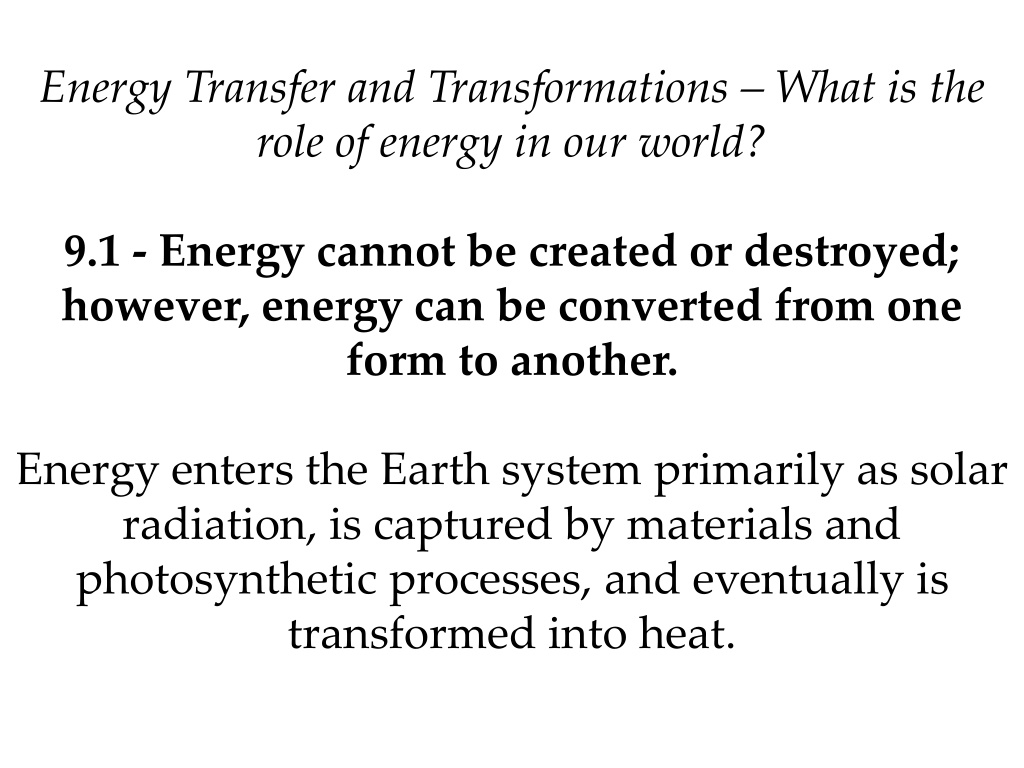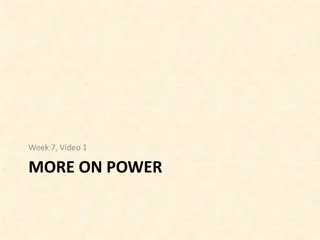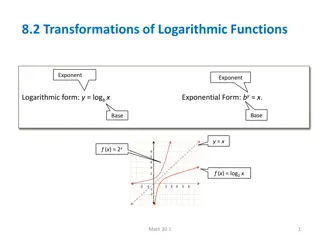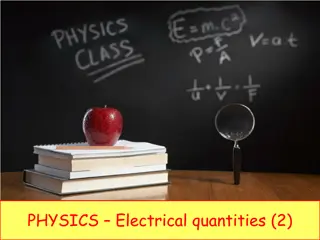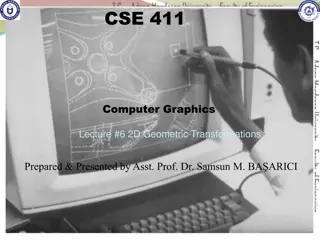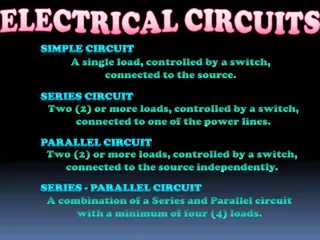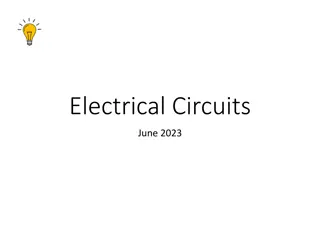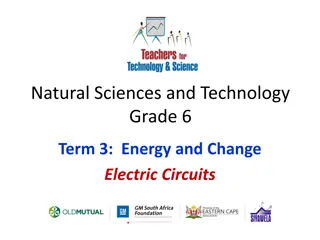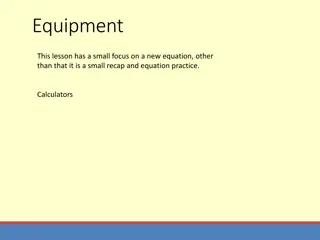Understanding Energy Transfer, Transformations, and Electrical Circuits
Energy plays a crucial role in our world, with the ability to be converted from one form to another. This content delves into the effects of adding energy to matter, energy transfer through conduction, convection, and radiation, and energy transformations among heat, light, electricity, and motion. It also explores the electrical force, relationship among voltage, current, and resistance in series circuits, and features a practical experiment with bulbs.
Download Presentation

Please find below an Image/Link to download the presentation.
The content on the website is provided AS IS for your information and personal use only. It may not be sold, licensed, or shared on other websites without obtaining consent from the author. Download presentation by click this link. If you encounter any issues during the download, it is possible that the publisher has removed the file from their server.
E N D
Presentation Transcript
Energy Transfer and Transformations What is the role of energy in our world? 9.1 - Energy cannot be created or destroyed; however, energy can be converted from one form to another. Energy enters the Earth system primarily as solar radiation, is captured by materials and photosynthetic processes, and eventually is transformed into heat.
D1. Describe the effects of adding energy to matter in terms of the motion of atoms and molecules, and the resulting phase changes. Explain what causes the two plateaus shown in the diagram above. (How is the energy being used?) What is happening to the particles while the temperature is increasing?
D2. Explain how energy is transferred by conduction, convection and radiation. Three beakers containing different materials are set up in front of a heat lamp. The initial temperature for all five substances is measured and the heat lamp is then turned on for 45 minutes. The temperatures are measured again after 45 minutes. List the five materials in order from hottest to coolest at the end of the time period. Give a reason for your ranking. Materials used: White Sea Sand , Pure Water, Black Sand Describe the process that creates convection currents.
D3. Describe energy transformations among heat, light, electricity and motion. The energy transformations taking place inside a coal power plant are: A) Chemical Thermal Motion Electrical B) Gravitational Thermal Mechanical Electrical C) Chemical Gravitational Thermal Radiant Electrical D) Thermal Radiant Chemical Motion Electrical
9.2 - The electrical force is a universal force that exists between any two charged objects. Moving electrical charges produce magnetic forces, and moving magnets can produce electrical force. Electrical current can be transformed into light through the excitation of electrons.
D4. Explain the relationship among voltage, current and resistance in a simple series circuit. As resistors are added to a series circuit, the total resistance of the circuit: A) Increases B) Decreases C) remains the same
A student sets up a sequence of series circuits, with between one and four bulbs. The student measures the voltage being used by bulb #1 in each circuit, as well as, the total resistance and total current for each circuit. The student s data is given on the table below, answer the following questions based on this data. A) What affect does adding resistance to a series circuit have on the rate of flow for the electrons in the circuit? B) What affect does adding bulbs have on the total resistance of the circuit? C) How does adding bulbs affect the amount of voltage available to each bulb?
D5. Explain how electricity is used to produce heat and light in incandescent bulbs and heating elements. Increasing the resistance of a wire in a circuit will cause the wire s ________ to increase. A) temperature B) voltage C) power output D) charge Describe how electricity passing through the filament of a bulb causes the bulb to give off light.
D6. Describe the relationship between current and magnetism. A substance is magnetic when: A) the majority of its domains have the same orientation B) it contains no magnetic domains C) it is made of aluminum D) the majority of its domains have different orientations Any time a wire is moved in a magnetic field: A) electricity is produced B) some of the magnetism is lost C) a magnet is made D) heat is produced
9.3 - Various sources of energy are used by humans and all have advantages and disadvantages. During the burning of fossil fuels, stored chemical energy is converted to electrical energy through heat transfer processes. In nuclear fission, matter is transformed directly into energy in a process that is several million times as energetic as chemical burning. Alternative energy sources are being explored and used to address the disadvantages of using fossil and nuclear fuels.
D7. Explain how heat is used to generate electricity. The operation of most power plants involves the heating of water to produce steam. How is this heat converted into electricity?
D8. Describe the availability, current uses and environmental issues related to the use of fossil and nuclear fuels to produce electricity. Describe a major environmental issue associated with the burning of fossil fuels to generate electricity? Describe a major environmental issue associated with the use of fission to generate electricity?
D9. Describe the availability, current uses and environmental issues related to the use of hydrogen fuel cells, wind and solar energy to produce electricity. Hydrogen fuel cells have an efficiency of 65% where as gas powered cars operate at 20% efficiency. Why haven t we switched all our cars to Hydrogen fuel cells? A) Hydrogen Fuel Cells are too expensive B) Hydrogen Fuel Cells can t operate at the car engine s temperature C) Hydrogen Fuel Cells are too heavy D) All of the above.
Properties of Matter How does the structure of matter affect the properties and uses of materials? 9.4 - Atoms react with one another to form new molecules. Atoms have a positively charged nucleus surrounded by negatively charged electrons. The configuration of atoms and molecules determines the properties of the materials.
D10. Describe the general structure of the atom, and explain how the properties of the first 20 elements in the Periodic Table are related to their atomic structures. In order for an atom to be neutral the: A) number of protons must equal the number of electrons B) number of protons must equal the number of neutrons C) number of electrons must equal the number of neutrons D) number of protons must be greater than the number of electrons Elements that are in the same family all (usually) have the same: A) Atomic Numbers B) valence energy level C) number of valence electrons D) number of protons
D11. Describe how atoms combine to form new substances by transferring electrons (ionic bonding) or sharing electrons (covalent bonding). When an atom becomes an ion it is always attempting to: A) gain electrons B) lose electrons C) share electrons D) obtain a complete valence energy level The chemical properties of elements are determined by gain, loss, or sharing of: A) electrons B) protons C) ions D) neutrons
A bond due to a transfer of electrons from a metal to a nonmetal is a(an): A) physical bond B) covalent bond C) ionic bond D) metallic bond Two atoms that are sharing a pair of electrons have formed a(n) _______ bond. A) Ionic B) Covalent C) James D) Cooperative Neon and Argon do not take part in any chemical changes. What is it about their atomic structure that accounts for this lack of reactivity?
D12. Explain the chemical composition of acids and bases, and explain the change of pH in neutralization reactions An acid's properties are due to the presence of: A) Na+ ions B) OH- ions C) H+ ions D) Cl- ions A base is a compound that contains: A) CO32- ions B) OH- ions C) H+ ions D) O2- ions
The reaction between an Acid and a Base is called: A) Single Replacement B) Decomposition C) Neutralization D) Combustion When an acid and base react, the resulting solution has a pH around: A) 1.0 B) 6.0 C) 7.0 D) 12.0
9.5 Due to its unique chemical structure, carbon forms many organic and inorganic compounds. Carbon atoms can bond to one another in chains, rings and branching networks to form a variety of structures, including fossil fuels, synthetic polymers and the large molecules of life.
D13. Explain how the structure of the carbon atom affects the type of bonds it forms in organic and inorganic molecules. The carbon atom can form _____ covalent bonds. A) 2 B) 3 C) 4 D) 5 Carbon is unique because it: A) can form long chain molecules B) can react with both metals and nonmetals C) has four valence electrons D) all of the above
D14. Describe combustion reactions of hydrocarbons and their resulting by-products. The products of the complete combustion of a hydrocarbon are _________ and __________. The combustion of gasoline in a car engine could be represented by the equation: C8H18 + O2 CO2 + CO + H2O + assorted particulates Classify this as either complete or incomplete combustion and give a reason for your classification.
D15. Explain the general formation and structure of carbon-based polymers, including synthetic polymers, such as polyethylene, and biopolymers, such as carbohydrate A polymer is made of a series of: A) atoms B) fuels C) monomers D) synthetic molecules An example of a natural polymer is A) copper B) wool C) crude oil D) plastic An example of a synthetic polymer is: A) protein B) plastic C) natural rubber D) cotton
9.6 - Chemical technologies present both risks and benefits to the health and well- being of humans, plants and animals. Materials produced from the cracking of petroleum are the starting points for the production of many synthetic compounds. The products of chemical technologies include synthetic fibers, pharmaceuticals, plastics and fuels.
D16. Explain how simple chemical monomers can be combined to create linear, branched and/or cross- linked polymers. Which of the following is a class of large, chain molecules made up of repeating units? A) Acids B) Bases C) Polymers D) Monomers The small molecules used to make a polymer are called: A) Monomers B) Bases C) Acids D) Radicals
D17. Explain how the chemical structure of polymers affects their physical properties. Straight Chain (Linear) polymers tend to be: A) high density and brittle B) low density and flexible C) high density and flexible D) low density and brittle
Adding branches to a polymer increases its: A) Density B) Brittleness C) Flexibility D) Strength Adding Cross links increases a polymers: A) Density B) Brittleness C) Flexibility D) Strength
D18. Explain the short- and long-term impacts of landfills and incineration of waste materials on the quality of the environment. Explain why the toughness and durability of many plastic polymers can be both an asset and a liability.
The Changing Earth How do materials cycle through the Earth s systems? 9.7 - Elements on Earth move among reservoirs in the solid earth, oceans, atmosphere and organisms as part of biogeochemical cycles. Elements on Earth exist in essentially fixed amounts and are located in various chemical reservoirs. The cyclical movement of matter between reservoirs is driven by the Earth s internal and external sources of energy.
D19. Explain how chemical and physical processes cause carbon to cycle through the major earth reservoirs. The fossilized remains of large trees that died thousands of years ago form A) minerals B) oil C) coal D) magma The fossilized remains of marine algae and large animals that died thousands of years ago form A) minerals B) oil C) coal D) magma
D20. Explain how solar energy causes water to cycle through the major earth reservoirs. Describe the path a drop of water will take from the ocean back to the ocean. What is the name of this cycle? What is the source of energy that starts this cycle? What effect would global warming have on this cycle?
D21. Explain how internal energy of the Earth causes matter to cycle through the magma and the solid earth. What is the source of the energy that starts this cycle? Explain how the newly formed oceanic crust gets created with a record of the earth s magnetic field. What physical feature of oceanic crust causes them to subduct under continental crust? What type of rock will be formed after magma is ejected out of the volcano at the right?
The on-going process by which rocks are repeatedly changed among the various types of rocks is known as: A) erosion B) the rock cycle C) metamorphism D) volcanism
9.8 - The use of resources by human populations may affect the quality of the environment. Emission of combustion by-products, such as SO2, CO2 and NOx by industries and vehicles is a major source of air pollution. Accumulation of metal and non-metal ions used to increase agricultural productivity is a major source of water pollution.
D22. Explain how the release of sulfur dioxide (SO2) into the atmosphere can form acid rain, and how acid rain affects water sources, organisms and human-made structures. The two of the gases that are major contributors to the production of acid rain are: A) CO2 and SOx B) CO2 and H2O C) SOx and NOx D) NOx and H2O Acid rain is defined as rain with a pH of: A) less than 5.0 B) 6.5exactly 5.5 C) less than D) more than 8.5
D23. Explain how the accumulation of carbon dioxide (CO2) in the atmosphere increases Earth s greenhouse effect and may cause climate changes. Base your answers to the next two questions on the diagram below. A. What does this diagram indicate about the affect of greenhouse gases? B. Carbon dioxide (CO2) is a major greenhouse gas. What affect would increased levels of CO2 have on the amount of trapped energy?
D24. Explain how the accumulation of mercury, phosphates and nitrates affects the quality of water and the organisms that live in rivers, lakes and oceans. Farmers have traditionally used large amounts of fertilizers that contain nitrates on their fields. Algae and other plants use nitrates as a source of food. If algae (microscopic water plants) have an unlimited source of nitrates, their growth is unchecked. Large algae growths reduce the oxygen level of rivers and lakes. A) Why is that a problem? B) What can be done to reduce or avoid this situation?
9.9 - Some materials can be recycled, but others accumulate in the environment and may affect the balance of the Earth systems. New technologies and changes in lifestyle can have positive and/or negative effects on the environment.
D25. Explain how land development, transportation options and consumption of resources may affect the environment. Landfills and Brownfield sites are an environmental concern because: A) they are located outside of population centers B) they may contain contaminants the can leak out into the surrounding area C) they raise the property value of the surrounding area D) all of the above
D26. Describe human efforts to reduce the consumption of raw materials and improve air and water quality. Turning off lights and using less air conditioning are examples of: A) waste B) conservation C) use D) recycling
